Deep Experience Report: How to Layout Web3 Social Protocol Lens Protocol in Advance?
Web3 Social Protocol Lens Protocol: A Deep Experience Report on PlanningEditor’s note by BlockingNews: Yesterday, Web3 social graph protocol Lens Protocol completed a $15 million financing round. Read this article to review this promising Web3 social protocol and early participation opportunities. This article is a re-release of an old article originally published on November 4, 2022.
On November 4th, according to Forbes, Web3 social protocol Lens Protocol received investment from FTX Ventures, but the specific investment amount was not disclosed. A spokesperson for the development team behind Aave Protocol and Lens Protocol confirmed that Lens Protocol is raising funds, but did not confirm the scale of this round of financing or the end date of the financing transaction. (Recommended reading: “Dialogue with Aave Executives: Lens Social Protocol, Stablecoin GHO and Cross-Chain Deployment”)
Recently, the discussion about Lens Protocol has once again increased in popularity, and the floor price of Lens handle NFT has risen from 0.003ETH to 0.018ETH, an increase of 600%. The official Lens also tweeted that it will be deployed on Scroll’s Pre-Alpha testnet, allowing developers to be at the forefront of building scalable Web3 social applications.
“Lens Protocol’s developer portal is the best he has ever seen for anyone who is developer-oriented. Lens Protocol clearly sets the funnel and target users, which brings great inspiration to the market.” Carlos, an engineer at DAO solution provider Aragon, wrote on Twitter.
- glassnode | DeFi Industry Status Report: How to Deal with the Downtrend
- VanEck Ethereum Valuation Report: ETH to Approach $12,000 by 2030
- Non-farm payroll report is mixed, there is still a possibility that the Fed may pause the rate hike in June.
Currently, the official Lens has distributed 93,900 profiles to the community through signing public letters and cooperation activities with project parties, with 86,422 holding addresses, and a unique holding rate as high as 92%, with only a 3% listing rate. According to the Lens data panel created by Dune user niftytable, the proportion of users in the Lens ecosystem who interact with the protocol 1-10 times is 76.8%, and the proportion of users who interact 10-50 times is 18.2%, and those who interact more than 50 times account for 5%. The number of monthly active users in the past six months is 10,000 to 20,000.

BlockingNews will explain in detail how Lens Protocol returns ownership to users, whether Lens Protocol can become a future development trend, how new users can enter the Lens ecosystem, and the interaction of current Lens ecosystem products.
What is Lens Protocol?
Lens Protocol is a composable decentralized social graph launched by the decentralized lending protocol Aave on the Polygon chain on February 8, 2022. Like our existing social media such as Weibo and Twitter, it has functions such as following, editing profile, posting, commenting, and forwarding posts.
The difference is that all user behaviors generated on the Lens Protocol are stored on the chain in the form of NFTs, supporting users to own all the content they create. The protocol has been designed modularly from the beginning, allowing for the addition of new features and fixes while ensuring that user-owned content and social relationships are immutable.
Currently, Web2 networks read data from centralized databases. Users’ personal profiles, social circles, and content are locked to specific networks and belong to the network operator. This leads to a zero-sum game where each application or network operator constantly competes for user attention. Moreover, all user behaviors on these applications or networks are not interoperable. For example, the content you post on Weibo only exists on Weibo, and if you want to display it on another platform, you need to register an account on the corresponding platform and post the content yourself.
The Lens protocol aims to solve the problems existing in current social media. By allowing users to create profiles and enabling profiles to interact with each other, Lens realizes that creators have their own connections to the community and forms a fully composable, decentralized social graph. The ownership of all user behaviors on products built on the Lens protocol belongs to the user, and users can bring them to any application built on the Lens protocol.
Profile NFT is the main object in the Lens protocol, and owning the NFT means that you control your own content. A single wallet address can own one or more Profile NFTs. The owner of the profiles creates and sets up personal profiles. Based on the profiles, users can follow (supporting paid and free), post, forward/mirror (supporting content distribution), comment, collect (supporting limited-time, limited-quantity paid or free methods), govern, and multisignature.
As mentioned above, Profile NFT represents the history of all the posts, mirrors, comments, and other content that you have created. By materializing all user behaviors into NFTs and storing them in the user’s decentralized wallet, the centralized island is removed, and the user achieves freedom of movement, while the platform is user-centric. The specific implementation is to tokenize and modularize user behaviors.
Tokenization means that the Lens protocol uses the ERC721 NFT to confirm the three levels of rights, which are fully composable, as follows:
1) LensHub: The upgradable contract LensHub is the core entry point for most interactions in the Lens protocol. Almost all interactions begin with and are compatible with ERC721 NFT contracts that are created when profiles are created.
2) FollowNFT: When a personal profile is first followed, a contract is deployed that makes the profile unique, and an ERC721 NFT contract representing the ownership of the follower is created.
3) CollectNFT: When a post is collected, a contract is deployed that represents the ERC721 NFT contract belonging to the post being collected.
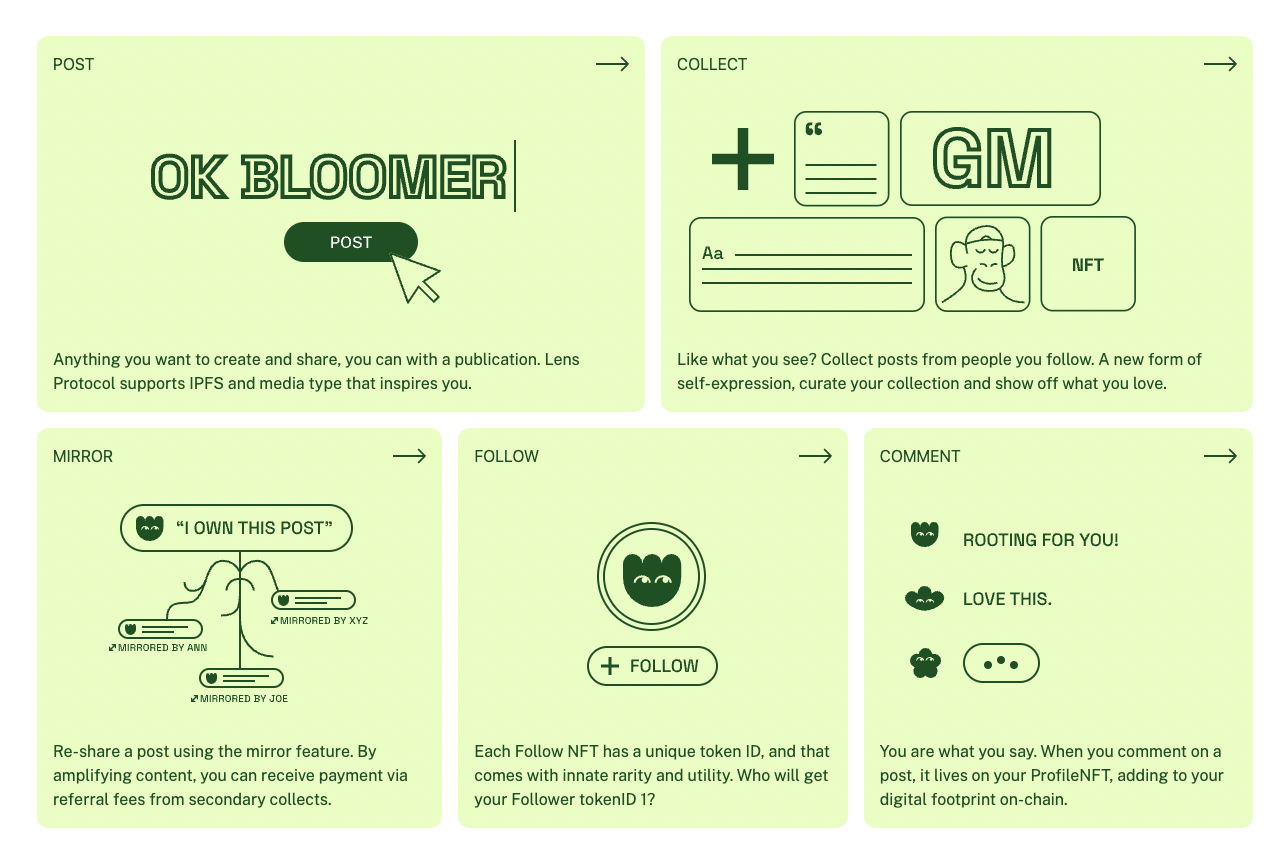
Modularity is at the core of the Lens protocol, where everything is built on the basis of community extension and continuous development of new innovative features. Modules are independent and have specific interfaces, potentially allowing for infinite expansion while maintaining the existing state.
1) Follow Module: This module is associated with profiles and contains the logic executed when a user attempts to follow a given profile.
2) Collect Module: This module is associated with a specific post (excluding mirror posts that cannot be collected) and contains the logic executed when a user attempts to collect a given post.
3) Reference Module: This module is associated with a specific post and contains the logic executed when a user attempts to comment or mirror a given post.
The following figure shows the part of the contract required for tokenization and modularity deployed on the Lens protocol:
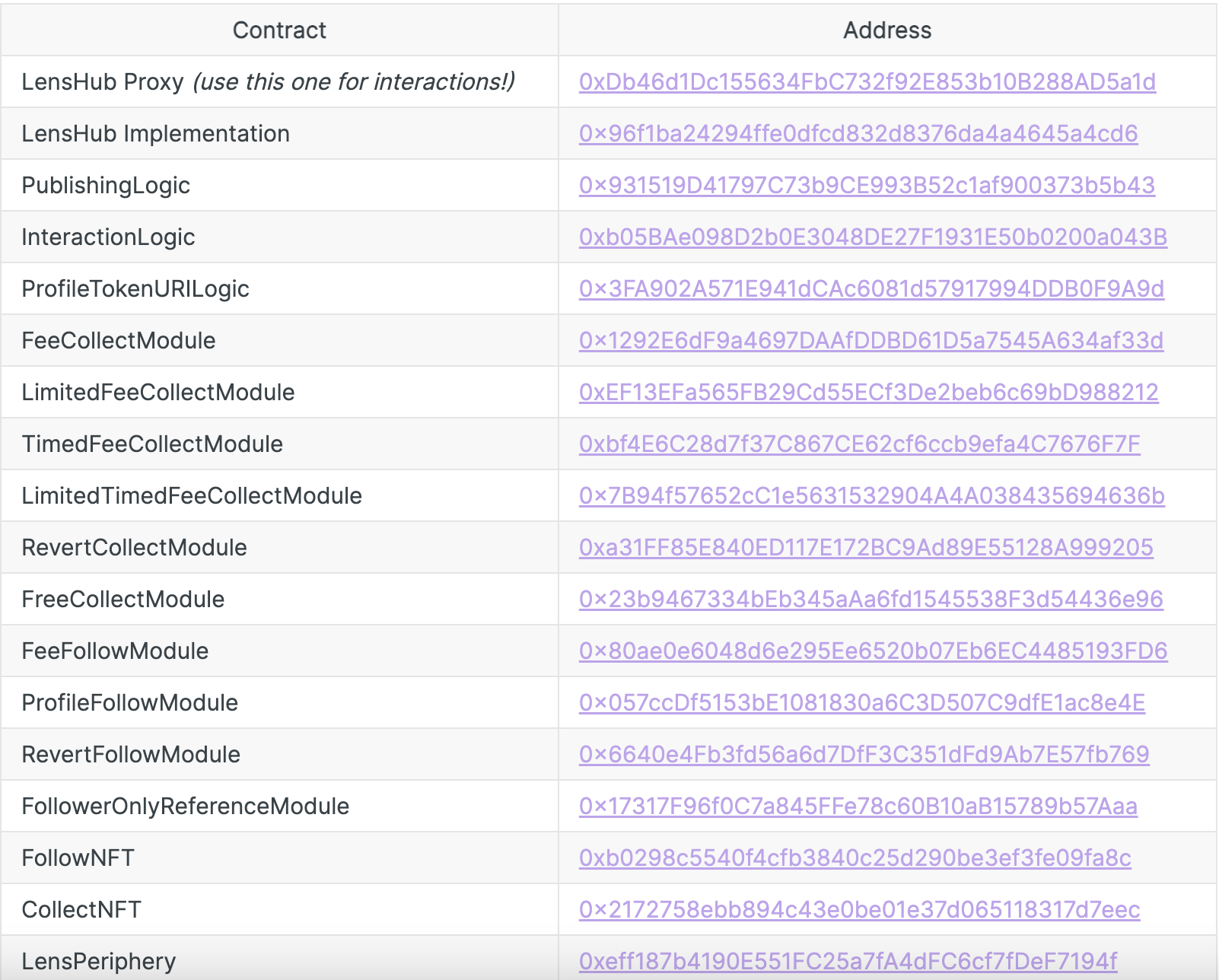
As mentioned above, governance is based on the interaction of Follow NFT contracts associated with profiles, which also include the ability to delegate power, delegate power over transactions, obtain specific block values, and obtain the total supply of delegated power for specific blocks. Of course, delegation is silent by default, so followers need to delegate themselves or another trusted user to participate in governance. Therefore, users can deploy a contract with a built-in interface for Follow NFT based on Lens protocol to create a DAO.
The multi-signature authorized operation can set governance and emergency management addresses, set treasury addresses and fees, whitelist assets, move the Lens protocol system to Publishing Blockingused or fully pause state, whitelist addresses to create profiles, whitelist Follow, Collect, and Reference modules, and upgrade the Lens protocol contract. The following operations cannot be performed: transfer funds from any user in the system, destroy any Follow or Collect NFT, destroy or edit any non-Lens NFT, and edit any other deployed contracts on the Lens protocol.
As the true owner of the content, creators no longer need to worry about losing their content, users, and business models due to changes in algorithms and policies based on a single platform. In addition, each application using the Lens protocol benefits and contributes to the entire ecosystem, turning the zero-sum game of Web2 into a collaborative game. Developers can truly focus on designing meaningful social experiences without relying on feedback mechanisms to lock in users’ attention.
Social Future Development Trends: Power Returns to Users
Stani, CEO of decentralized lending protocol Aave, mentioned at Ethereum Bogota Devcon6 that from TV to the current development of social software, there has been such a rapid development that it has a very complete infrastructure, making it easy to innovate and generate compound effects. TikTok, for example, has taken seven years to grow from 0 to 1 billion users. Internet applications are globally accessible, just like the Ethereum ecosystem and community.
Accessibility is the most important part of the innovation flywheel, and social media will be the next killer-level application with network effects. This is because there are currently 5 billion users on social media, and the number is constantly increasing. People need to connect with each other, create and create, and create communities that produce a sense of belonging. Thus, social capital is generated.
However, many social media platforms do not protect users’ social capital or allow them to express what they want to express. Network socializing is still a zero-sum game, and you cannot transfer your social assets. You are locked into a platform and cannot get your own benefits.
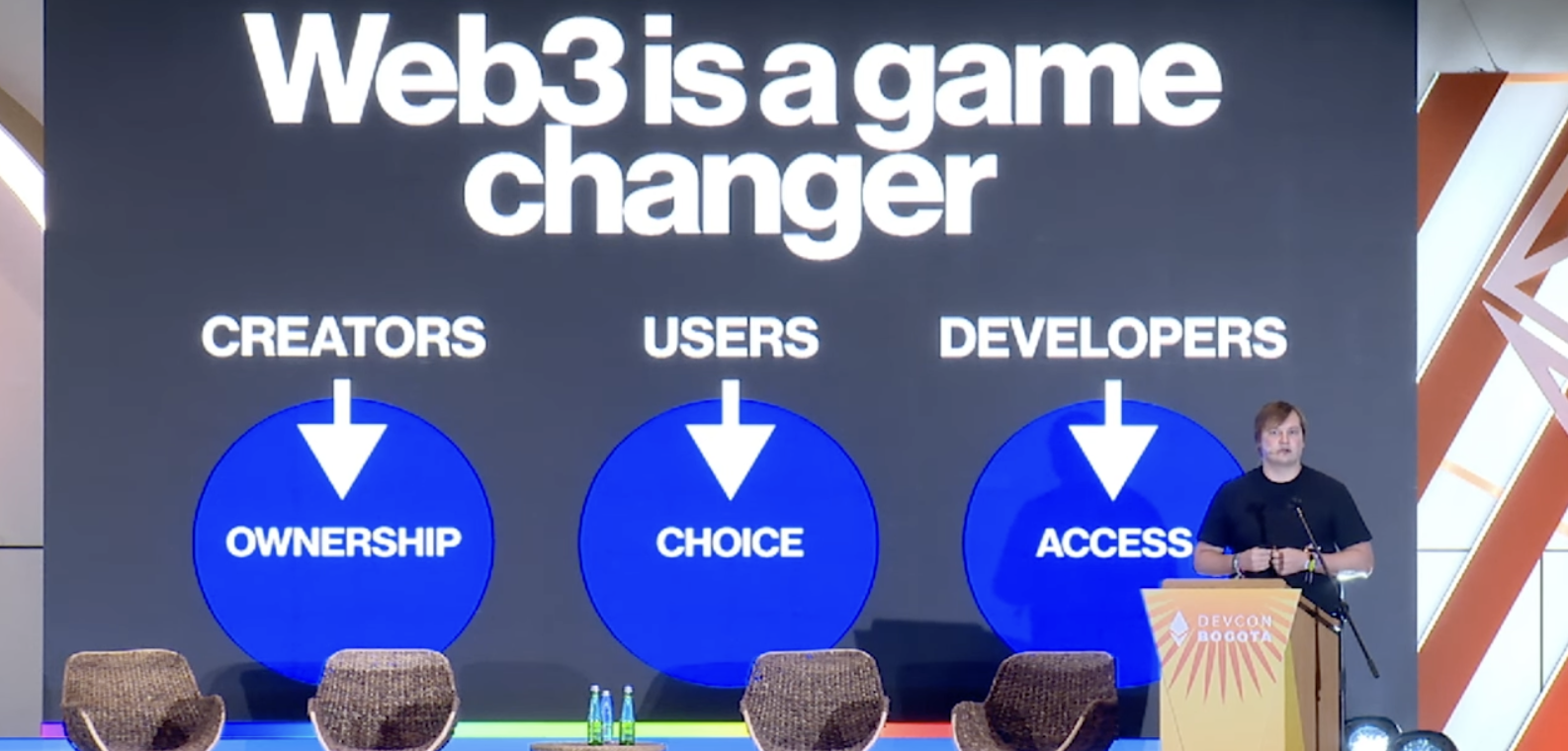
On Web3 social platforms, users own content distribution ownership, and can decide how to distribute content to users who follow them, and they are not locked into a specific platform, and do not need to use specific identities to log in, so users can freely choose the platform with the best service and algorithm.
From a personal identity perspective, users create connectivity architecture such as personal profiles and social maps on open Web3 platforms, thus generating social capital. From the perspective of organizations, users generate social verification, and communities can also freely build new algorithms to keep community consensus consistent. From the perspective of creators, they have their own distribution channels and can monetize their content, and users also have unique ways to create their own monetization. Monetization and financialization are part of the value proposition of Web3 social networks.
At the same time, creators can build products based on the Lens protocol without worrying about user growth. The user growth of Web3 products depends on the development of the ecosystem and industry, and the speed of industry growth is much faster than the product’s ability to attract users.
In the 2022 Binance fifth anniversary founder’s open letter, it was revealed that the number of users has reached 120 million, which is the dividend brought about by the rapid development of the entire industry. For creators, choosing the right ecosystem and direction will be twice the result with half the effort.
How new users can enter the Lens ecosystem
In the early days of Lens, Profiles were distributed to the community through open letters and cooperation with project parties. Users who received Profiles could then set up a lens handle (similar to a Twitter handle) and follow, post, comment, and favorite on products built on Lens.
According to a Lens data panel created by Dune user niftytable, Lens Profiles grow by 10,000 to 20,000 per month, with a portion coming from the distribution of open letters and cooperation with project activities.
Currently, new users have three ways to obtain Profiles. The first is to sign an open letter on the Lens official website and wait for Profiles to be distributed, the waiting time for which is uncertain and depends on official announcements. The second is to purchase them on the Opensea secondary market. The third is to follow Lens official events, which occasionally cooperate with project parties to distribute Profiles.
A Profile is not just a personal social circle; you can develop products on it, such as e-commerce and knowledge payment. AAVE and Lens protocol founder Stani tweeted on July 13, 2022 that Lens Protocol users had earned over $125,000 in the first month after the mainnet launch without intermediaries.
Regarding whether Lens Profiles will be open for application in the future, there are two opposing views in the community. One is that it may never be opened to prevent cheaters and reduce dead accounts. Since Lens handle is tradable, it provides a channel for users who really want to participate in the Lens ecosystem. If users want to put all their social activities on the chain, they can purchase it on the secondary market. The other view is that it is believed that it will be opened. Not opening it may prevent cheating, but it also increases the entry threshold and cost for ordinary people, which greatly hinders the development of the protocol itself.
Lens Ecosystem Product Experience
From the beginning of the launch of the Lens Protocol, it has opened funding programs to individuals, independent teams, non-profit organizations, companies, universities, and scholars, including but not limited to the following types of projects: analysis, collection, creator profit, community tools, curation, DAO tools, developer tools, personal identity, mobile experience, social media, spam/audit, and ticketing/events. The following are currently selected Lens official ecological projects:
Lensfrens
Lensfrens is a Lens Profiles curation webpage built by the Lens team. LensFrens recommends Profiles that users may be interested in based on their wallet transaction history, and users can also search for Profiles to follow directly on Lensfrens. Users’ personal Profile pages on the Lens protocol will also directly jump to the LensFrens page.
https://www.lensfrens.xyz/
Lenster
Lenster is a decentralized social media application built on the Lens protocol and one of the 12 winning projects of the Lens hackathon LFGrow. The official Twitter account has 15K followers, and the Discord channel has 12K users.
Users’ NFTs and resolved ENS domains in the wallet used to log in to Lenster are also displayed in their personal Profiles. Similar to Twitter, users can follow, post (supporting images, GIFs, audio, and video), comment, repost/mirror, and collect posts on Lenster. Users can also search for related content posts or user Profiles directly on Lenster. Users can allow or remove these modules in their Lenster profile settings.
When posting on Lenster, users can choose the accessible objects (followers, followed, friends of friends, and everyone), and can also choose whether to allow other users to collect the post as needed. Users can also set a collection fee for post collectors. Lenster has also launched content distribution. If a user pays to collect a post via your repost, you will also receive a share of the revenue. The default value is currently 15%.

Website: https://lenster.xyz/
Lenstube
Lenstube is an open-source video sharing social media platform supported by Livepeer and Vercel. Like Lenster, creators can choose the video Collect object when uploading videos, limit the number of Collectors, video categories, and set collection and recommendation fees. Creators can also directly repost and synchronize published videos to Lens. The official Twitter account has 8.8K followers.
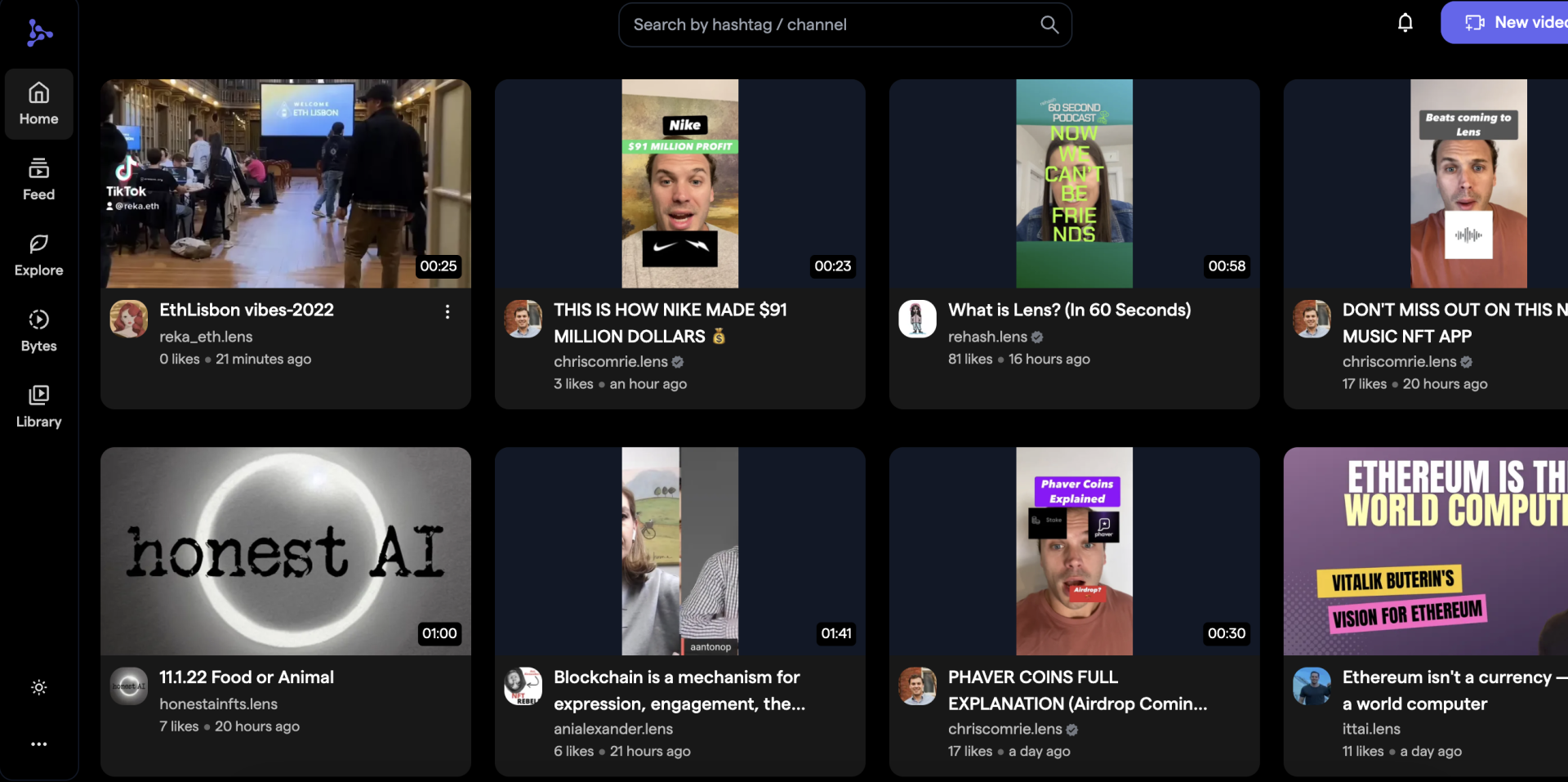
https://lenstube.xyz/
ORB
ORB is a decentralized professional social media application with an end-to-end chain-based reputation system that connects companies, projects, and users and is suitable for Web3 practitioners. ORB has been launched on the App Store and Google Play, and users can apply for internal testing. The Twitter account has 16K followers, and the Discord channel has 10K users.
On ORB, users can create a decentralized professional profile and build on-chain credibility by linking various NFTs and POAPs to their experience, education, skills, and projects, as well as explore job opportunities and apply for on-chain identities. Users can also share their ideas on-chain, connect with Web3 practitioners, and build a community. In addition, users can use fragmented time to learn Web3 knowledge and earn NFTs, which is known as Learn-to-Earn.
Website: https://orb.ac/
Phaver
Phaver is a decentralized social app that allows users to share and earn. It is supported by Lens. It has 55K followers on Twitter and 41K users on Discord.
Users can post articles, links, products, and apps on Phaver. They can also browse all user content on Lens, and Lens users can directly post on Lens via Phaver. Phaver is currently in beta testing (Lens Profile username can be used as an invitation code).
Phaver distributes 5 tokens to users every day. Users can stake them on 5 posts when browsing content. The token rewards depend on the popularity and duration of staking, helping users discover the best content. Users can also interact with the official Twitter and Discord accounts to earn SBT.
Website: https://phaver.com/
Rememe
Rememe is an on-chain meme generator based on the Lens protocol, built by the Newt experimental team of the Aave team. Users can authorize their memes directly on Lenster after creating them.

Website: https://www.rememe.lol/
LensPort
LensPort is an NFT marketplace for content and profile transactions on the Lens protocol. It was launched in October 2022 and has 4.4K followers on Twitter. It combines a social platform with an NFT marketplace, allowing users to post, discover, sell, and purchase posts or profiles, as well as trade profiles. However, the number of users is currently low, and Lens Profile transaction volume is less than 1 ETH.

Website: https://lensport.io/
Lensta
Lensta is an image stream platform for the Lens protocol. Users can browse the latest, most popular, mirrored/reposted, and most collected posts with images on the Lens protocol.
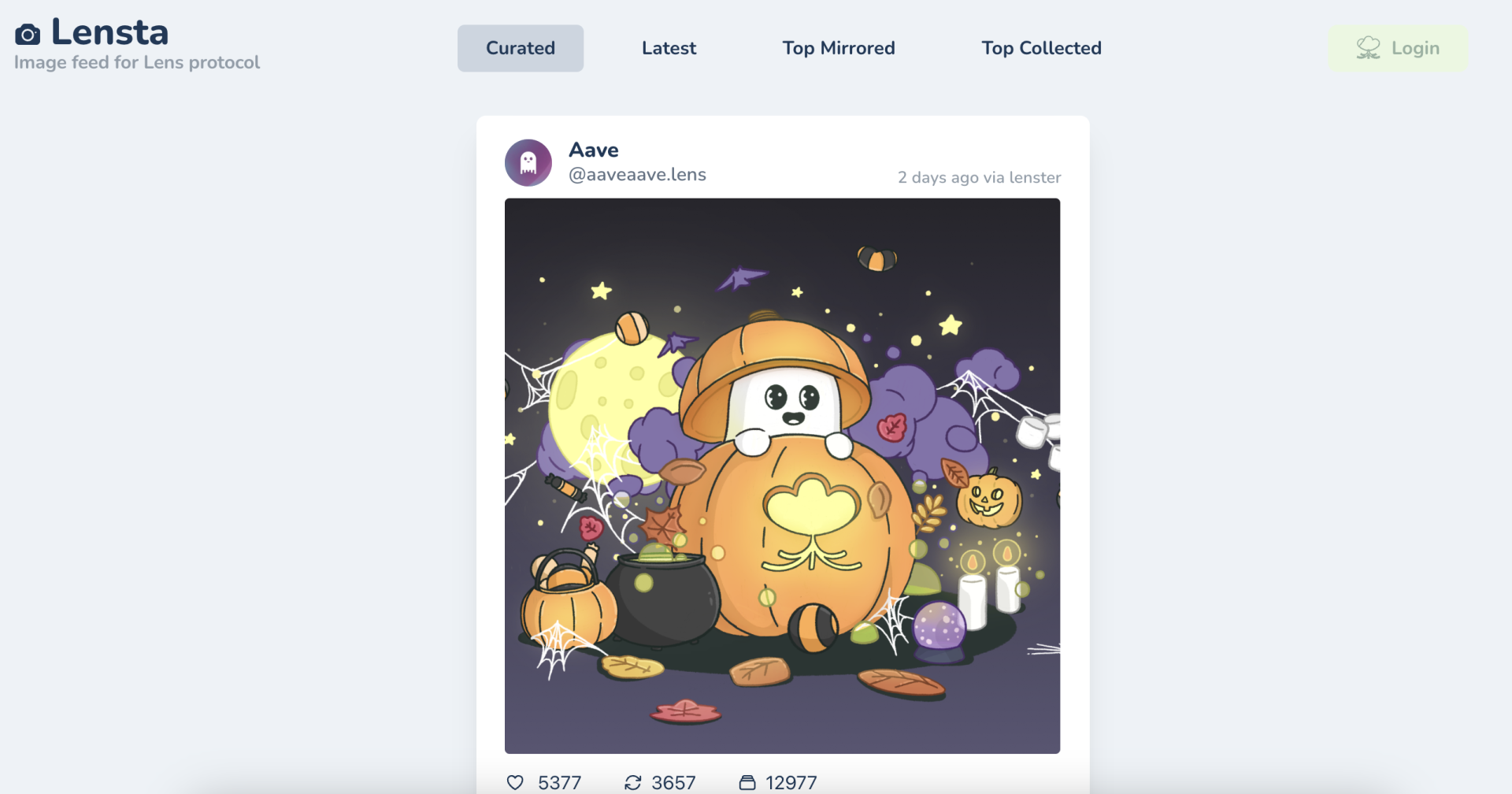
https://www.lensta.xyz/
dashuo, the founder of the NFT derivative community CreatorDAO, once stated on social media that the official Lens protocol has been very restrained in terms of user growth, such as not doing content aggregation and recommendation. However, not doing content algorithm recommendation is not conducive to the protocol and platform user activity and retention. But after user historical behavior data is stored in the user’s personal wallet in the form of NFTs, users do not have to worry about being banned and do not have to consume energy on multiple non-interoperable Web2 platforms, and can leave the platform at any time without any loss.
For us personally, now is the best time to learn about and enter the Lens ecosystem, enrich our personal history of behaviors on the Lens protocol, and generate more NFT data.
We will continue to update Blocking; if you have any questions or suggestions, please contact us!
Was this article helpful?
93 out of 132 found this helpful
Related articles
- Token Analysis Framework: Identifying the Potential and Returns of Low Market Cap Tokens
- Research on the major wallet risks of Binance, KuCoin, and Jump: Are assets stored in large institutions 100% safe?
- IOSG Weekly Report: An Analysis of Full-Stack Game Engines
- Report on the Development of Zksync Ecosystem Two Months after the Mainnet Launch
- Interpretation of the 2023 DeFi Status Survey Report
- Report on the Development of the Zksync Ecosystem Two Months after Mainnet Launch
- LD Capital: Zksync Mainnet Goes Live for Two Months, Ecological Development Report





